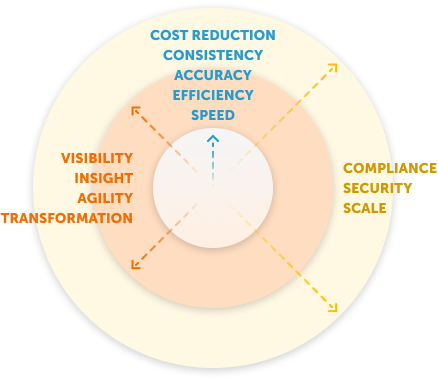
Hyperautomation was identified by Gartner as one of 2020’s top 10 strategic technology trends and will continue beyond.
So what is hyperautomation? It’s the extension of legacy business process automation beyond the confines of individual processes. By marrying AI tools with RPA, hyperautomation enables automation for virtually any repetitive task executed by business users. It even takes it to the next level and automates the automation - dynamically discovering business processes and creating bots to automate them.
With a range of tools like Robotic Process Automation (RPA), machine learning (ML), and artificial intelligence (AI), working in harmony to automate complex business processes—including where subject matter experts were once required—hyperautomation is a means for real digital transformation.
WHAT ARE THE BENEFITS OF HYPERAUTOMATION?
Accelerating Complex Work
Hyperautomation provides a high-speed route to engaging everyone in transforming the business, supported by automating more and more complex work that relies on knowledge input from people.
Deploying Digital Workers
Upskilling RPA with intelligence creates an intelligent Digital Workforce that can take on repetitive tasks to augment employee performance. These Digital Workers are the change agents of hyperautomation, able to connect to various business applications, operate with structured and unstructured data, analyze data and make decisions, and discover processes and new automation opportunities.
The Power of Artificial Intelligence (AI)
AI is what differentiates Digital Workers from standard automation approaches—making RPA+AI the essential ingredients of hyperautomation.
And by uncovering and automating previously inaccessible data and processes, hyperautomation offers another unique benefit: the creation of a digital twin of the organization (DTO). How does that help? A DTO makes visible the previously unseen interactions between processes, functions, and key performance indicators.
Imagine seeing business value creation as it happens—or doesn’t happen—and leveraging the intelligence to rapidly respond as well as identify new opportunities.
Digital Worker - The lights out operator
The two business domains of IT and operational technology (OT) are starting to merge through the use of Hyperautomation and digital orchestration. They enable data rationalization and technology synchronization across the organization, creating unified, holistic, value-driven workflows and giving birth to the possibility of lights-out factories, logistical centers, and offices. These facilities operate around the clock with no human presence, and all operations controlled remotely.
HyperAutomation and Digital Orchestration also enable all the traditional business-based functions. They are orchestrating ERPs and invoicing, with electronic and physical mail systems.
This creates new mobile and web-based platforms for clients to submit any sort of order that needs processing, synchronizing all the activities and logistics needed to fulfill the request.
How can HyperAutomation help with Invoicing in your organisation?
Automated Matching Rules- Automated invoice processing uses 2 or 3 way matching rules to ensure the invoiced products align with orders and receipts.
Approval anytime from anywhere – With invoice automation, users can approve directly from their mobile devices. They can approve from their email without login required. Automated invoicing notification reduces manual follow ups.
Adjustable tolerances – Automated invoicing processing set the invoicing feature, which controls what process requires an automatic match and what requires manual review with tolerance settings. This automatic invoicing feature can be set globally or at the commodity level by the business team.
Exception routing and review – Based on tolerance and routing rules, in invoice processing automation, non-matching invoices are flagged and routed for review and resolution.
Early payment discounts – Early payment discounts opportunities can be notified to prioritize and process the payments with invoice processing automation.
Quick payment and billing without reminders – With invoice automation, matching invoices get paid and billed to the respective expense accounts without reminders
Central invoice processing – Eliminate the cost, risk and delay of shipping goods with central processing facilities
Links